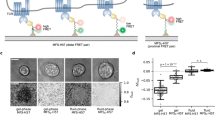Abstract
Cells of the adaptive immune system recognize pathogenic peptides through specialized receptors on their membranes. The engagement of these receptors with antigen leads to cell activation, which induces profound changes in the cell including cytoskeleton remodeling and membrane deformation. During this process, receptors and signaling molecules undergo spatiotemporal reorganization to form signaling microclusters and the immunological synapse. The cytoskeletal and membrane dynamics also leads to exertion of forces on the cell-substrate interface. In this chapter we describe two techniques—one for single-molecule imaging of B cell receptors to measure their diffusive properties as cells get activated on supported lipid bilayers; and the second for visualizing and quantifying cellular forces using elastic surfaces to stimulate T and B cells.
Access this chapter
Tax calculation will be finalised at checkout
Purchases are for personal use only
Similar content being viewed by others
References
Bonilla FA, Oettgen HC (2010) Adaptive immunity. J Allergy Clin Immunol 125(2 Suppl 2):S33–S40
Dustin ML, Groves JT (2012) Receptor signaling clusters in the immune synapse. Annu Rev Biophys 41:543–556
Harwood NE, Batista FD (2010) Early events in B cell activation. Annu Rev Immunol 28:185–210
Fleire SJ et al (2006) B cell ligand discrimination through a spreading and contraction response. Science 312(5774):738–741
Song W et al (2013) Actin-mediated feedback loops in B-cell receptor signaling. Immunol Rev 256(1):177–189
Ketchum C, Miller H, Song W, Upadhyaya A (2014) Ligand mobility regulates B cell receptor clustering and signaling activation. Biophys J 106(1):26–36
Treanor B, Batista FD (2010) Organisation and dynamics of antigen receptors: implications for lymphocyte signalling. Curr Opin Immunol 22(3):299–307
Treanor B, Depoil D, Bruckbauer A, Batista FD (2011) Dynamic cortical actin remodeling by ERM proteins controls BCR microcluster organization and integrity. J Exp Med 208(5):1055–1068
Treanor B, Harwood NE, Batista FD (2009) Microsignalosomes: spatially resolved receptor signalling. Biochem Soc Trans 37(Pt 5):1014–1018
Batista FD, Treanor B, Harwood NE (2010) Visualizing a role for the actin cytoskeleton in the regulation of B-cell activation. Immunol Rev 237(1):191–204
Liu C et al (2013) N-wasp is essential for the negative regulation of B cell receptor signaling. PLoS Biol 11(11):e1001704
Liu C et al (2011) A balance of Bruton’s tyrosine kinase and SHIP activation regulates B cell receptor cluster formation by controlling actin remodeling. J Immunol 187(1):230–239
Wan Z et al (2013) B cell activation is regulated by the stiffness properties of the substrate presenting the antigens. J Immunol 190(9):4661–4675
Giannone G et al (2010) Dynamic superresolution imaging of endogenous proteins on living cells at ultra-high density. Biophys J 99(4):1303–1310
Betzig E et al (2006) Imaging intracellular fluorescent proteins at nanometer resolution. Science 313(5793):1642–1645
Manley S et al (2008) High-density mapping of single-molecule trajectories with photoactivated localization microscopy. Nat Methods 5(2):155–157
Bates M, Huang B, Dempsey GT, Zhuang X (2007) Multicolor super-resolution imaging with photo-switchable fluorescent probes. Science 317(5845):1749–1753
Rust MJ, Bates M, Zhuang X (2006) Sub-diffraction-limit imaging by stochastic optical reconstruction microscopy (STORM). Nat Methods 3(10):793–795
Thompson RE, Larson DR, Webb WW (2002) Precise nanometer localization analysis for individual fluorescent probes. Biophys J 82(5):2775–2783
Murase K et al (2004) Ultrafine membrane compartments for molecular diffusion as revealed by single molecule techniques. Biophys J 86(6):4075–4093
Natkanski E et al (2013) B cells use mechanical energy to discriminate antigen affinities. Science 340(6140):1587–1590
Hui KL, Balagopalan L, Samelson LE, Upadhyaya A (2015) Cytoskeletal forces during signaling activation in Jurkat T-cells. Mol Biol Cell 26(4):685–695
Dembo M, Wang YL (1999) Stresses at the cell-to-substrate interface during locomotion of fibroblasts. Biophys J 76(4):2307–2316
Butler JP, Tolic-Norrelykke IM, Fabry B, Fredberg JJ (2002) Traction fields, moments, and strain energy that cells exert on their surroundings. Am J Physiol 282(3):C595–C605
Gardel ML et al (2008) Traction stress in focal adhesions correlates biphasically with actin retrograde flow speed. J Cell Biol 183(6):999–1005
Peluso P et al (2003) Optimizing antibody immobilization strategies for the construction of protein microarrays. Anal Biochem 312(2):113–124
Li TP, Song Y, MacGillavry HD, Blanpied TA, Raghavachari S (2016) Protein crowding within the postsynaptic density can impede the escape of membrane proteins. J Neurosci 36(15):4276–4295
Chenouard N et al (2014) Objective comparison of particle tracking methods. Nat Methods 11(3):281–289
Han SJ, Oak Y, Groisman A, Danuser G (2015) Traction microscopy to identify force modulation in subresolution adhesions. Nat Methods 12(7):653–656
Del Alamo JC et al (2007) Spatio-temporal analysis of eukaryotic cell motility by improved force cytometry. Proc Natl Acad Sci U S A 104(33):13343–13348
Sohn HW, Tolar P, Pierce SK (2008) Membrane heterogeneities in the formation of B cell receptor–Lyn kinase microclusters and the immune synapse. J Cell Biol 182:367 LP-379
Acknowledgments
We thank Dr. Thomas Blanpied and Dr. Peter Luo (University of Maryland, School of Medicine) for their help and guidance in establishing the experimental protocol, single-molecule localization, and tracking. We thank Dr. King Lam Hui for optimizing the protocol for making the 2-layer gel used for traction force microscopy. This work was supported by the grants NIH AI122205 and NSF 1563355 to AU.
Author information
Authors and Affiliations
Corresponding author
Editor information
Editors and Affiliations
Rights and permissions
Copyright information
© 2018 Springer Science+Business Media, LLC
About this protocol
Cite this protocol
Rey, I., Garcia, D.A., Wheatley, B.A., Song, W., Upadhyaya, A. (2018). Biophysical Techniques to Study B Cell Activation: Single-Molecule Imaging and Force Measurements. In: Liu, C. (eds) B Cell Receptor Signaling. Methods in Molecular Biology, vol 1707. Humana Press, New York, NY. https://doi.org/10.1007/978-1-4939-7474-0_4
Download citation
DOI: https://doi.org/10.1007/978-1-4939-7474-0_4
Published:
Publisher Name: Humana Press, New York, NY
Print ISBN: 978-1-4939-7473-3
Online ISBN: 978-1-4939-7474-0
eBook Packages: Springer Protocols




